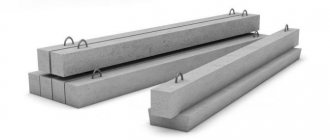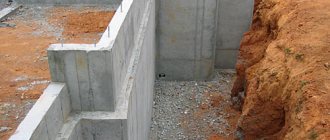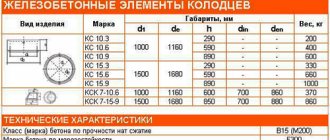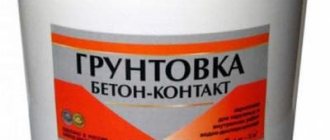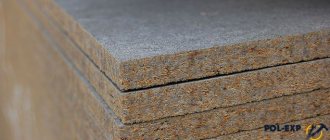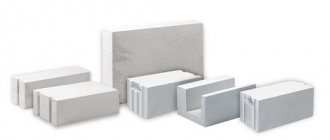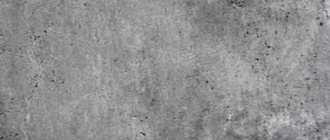How to attach sleepers to the foundation?
The first row of sleepers is fastened
to the
foundation
with bolts embedded in it.
Therefore, it is necessary to drill holes in each sleeper
so that they coincide with the pitch of the already installed bolted connections.
The bottom row of sleepers
must be treated with bitumen for waterproofing, and rolled roofing felt should be laid in two layers on top of the first row.
Interesting materials:
How to calculate lamps on a suspended ceiling? How to calculate the thermal power of a steel radiator? How to calculate a transformer for a tape? How to calculate the price of land? How to calculate CPS per square meter? How to calculate the specific gravity of reinforcement? How to calculate vanilla sugar? How to calculate the weight of a road slab? How to calculate a gutter? How to calculate the output of solar panels?
Ask a Question
Checkout
Reinforced concrete sleepers are the main components of railway tracks. Currently, they are widely used in contrast to wooden sleepers. In a railway track, the support is laid on the upper structure of the ballast layer, which creates stability in the relative position of the rail threads. The pressure perceived from intermediate fastenings or from rails is transferred to the ballast layer (sleeper base). The main advantage is the creation of the best possible elasticity of rail supports. Along with this, sleepers are more resistant to rotting and also have greater crush strength. The service life of reinforced concrete sleepers under daily load reaches an average of 50 years. Practice shows that the movement of a train on reinforced concrete sleepers is smoother, while creating the best conditions for the operation of a continuous continuous track due to high lateral stability. The production of sleepers is carried out directly in accordance with the requirements specified in GOST. There are a number of basic technical characteristics for the production of reinforced concrete sleepers. • Length – 2700 mm. • Width – 300 mm. • Height – 230 mm. • Frost resistance – no less than F200 • Concrete category – no less than B40 (M500)
Reinforced concrete sleepers are a fairly complex structure that is subject to various weather conditions and is also subject to daily extreme loads. Reinforced concrete sleepers of the modern type are all-beam sleepers made of prestressed reinforced concrete, reinforced with high-strength wire, fully satisfying TU 5864 - 019 - 11337151-95 and GOST 10629-88. Classification of reinforced concrete sleepers:
• Reinforced concrete sleepers Ш 1-1 (the angle of inclination of the thrust edges of the under-rail pads in the sleepers is 55 degrees) are used for separate terminal-bolted fastening of the CB with bolted attachment of the lining to the sleeper. They are made from heavy concrete of compressive strength class B40 (M500). The frost resistance grade of concrete must be at least F200 (Mrz200). For concrete sleepers, crushed stone (from natural stone or gravel) of a fraction of 5-20 mm is used. GOST 10629-88.
• Reinforced concrete sleepers Ш 1-2 (the angle of inclination of the thrust edges of the under-rail pads in the sleepers is 72 degrees) are used for separate terminal-bolted fastening of the CB with bolted attachment of the lining to the sleeper. GOST 10629-88.
• Reinforced concrete sleepers Ш 2-1 are used for continuous clamp-bolt rail fastening of the BPU with bolted attachment of the lining or rail to the sleeper. GOST 10629.
• Reinforced concrete sleepers Ш 3 are used for inseparable terminal-bolt fastening of ZhBR65 with bolting of the rail to the sleeper.
• ShS-ARS reinforced concrete sleepers are used for anchor rail fastening.
• Reinforced concrete sleepers Ш 1-16*5 - sleepers with high-strength wire reinforcement of a periodic profile with a diameter of 3 to 5 mm.
• Reinforced concrete sleepers Ш 1-4*10 are sleepers with high-strength bar reinforcement of a periodic profile with a diameter of bars from 7 to 12 mm.
For sleepers, periodic steel wire is widely used as reinforcement. In this case, its diameter should be 3 mm, and the wire itself should be of class Vr. The number of wires in the nominal scale is 44, each of which is tensioned with a special force of 8.1 kN. In contrast to crack resistance, geometric parameters and quality of concrete surfaces are divided into two categories: first and second. Laying on access roads, as well as on stationary and inactive ones, is carried out using second-grade sleepers. Moreover, delivery occurs only with the consent of the consumer. On P65 rails with KB fastening, the tonnage production is at least 2000 million tons gross. The volume of defects in reinforced concrete sleepers during the total output and repair of all types does not exceed 5-6% after missing 1.0 billion tons gross. The most significant savings come from relaying old reinforced concrete sleepers removed from tracks of the 1st and 2nd categories during major repairs, on tracks of 3-4 classes and access roads of industrial enterprises. When transporting reinforced concrete sleepers, it is necessary to be guided by the requirements of GOST 13015-2003; this requirement also directly applies to storage methods. Sleepers must be stored in stacks; the rows must be strictly horizontal and with the sole down, i.e. in the working position. The stack should be 16 rows high, but no more! It is also necessary to lay wooden pads under the sleepers and between them. They are placed in recesses between the sleepers. The minimum thickness of the pads is 50 mm. It is permissible to deviate from the use of wooden spacers with a cross-section of at least 40x40 mm, but only with the approval of the consumer. Transportation is carried out in gondola cars or on a truck. It is unacceptable to transport different brands in the same carriage or car body. The manufacturer of reinforced concrete sleepers provides a warranty period of 3 years from the moment they are laid on railway tracks.
| Reinforced concrete sleeper Ш-1 (grade-1) Dimensions (L x W x H in mm.): x |
| Reinforced concrete sleeper Ш-3 (grade-1) Dimensions (L x W x H in mm.): x |
| Reinforced concrete sleeper ARS Dimensions (L x W x H in mm.): x |
| Reinforced concrete bridge sleeper Ш-1М Dimensions (L x W x H in mm): x |
| Used reinforced concrete sleeper Dimensions (L x W x H in mm.): x |
Ask a Question
Checkout
Impregnated wooden sleepers type I GOST
| Characteristic | Meaning |
| Thickness h, mm | 180 ± 5 |
| Height of sawn sides h2, mm | 150 |
| Width of the top plane b, mm | 180 |
| Width of the upper plane b', mm | 210 |
| Width of the bottom plane b1, mm | 250 ± 5 |
| Length L, mm | 2750 ± 20 |
Drawing:
| Type | Thickness, mm h | Height of sawn sides, mm h2 | Width | ||
| Top face, mm | Bottom plate, mm | ||||
| b | b' | b1 | |||
| Type-I | 180 | 150 | 180 | 210 | 260 |
| Type-II | 160 | 130 | 150 | 195 | 230 |
| Length of beams, m | Kit type | A1 | A2 | A3 | A4 | B1 | B2 | B3 | B | ||
| Rail type | P65 | P65, P50 | P65 | P65 | P50, P43 | P50, P43 | P50 | P65 | Cross switches P65, P50, P43 | ||
| Turnout brand | 1/22 | 1/18 | 1/11 | 1/9 | 1/11 | 1/9 | 1/7 | 1/6 | 1/6 | ||
| Conditional number of timber length | Number of bars included, pcs | ||||||||||
| 3,00 | 1 | 16 | 31 | 16 | 17 | 16 | 17 | 16 | 12 | 10 | — |
| 3,25 | 2 | 39 | 16 | 10 | 10 | 8 | 7 | 4 | 5 | 6 | — |
| 3,50 | 3 | 21 | 17 | 8 | 8 | 7 | 7 | 7 | 4 | 4 | 19 |
| 3,75 | 4 | 16 | 12 | 7 | 4 | 8 | 5 | 2 | 3 | 3 | 18 |
| 4,00 | 5 | 14 | 11 | 5 | 6 | 4 | 3 | 7 | 3 | 3 | 8 |
| 4,25 | 6 | 12 | 9 | 6 | 5 | 6 | 4 | 2 | 2 | 3 | 8 |
| 4,50 | 7 | 10 | 8 | 7 | 6 | 7 | 7 | 10 | 5 | 3 | 10 |
| 4,75 | 8 | 10 | 9 | 6 | 4 | 5 | 4 | 4 | 3 | 3 | 8 |
| 5,00 | 9 | 11 | 9 | 5 | 4 | 5 | 5 | 4 | 3 | 3 | 8 |
| 5,25 | 10 | 10 | 8 | 6 | 4 | 6 | 4 | 2 | 4 | 4 | 8 |
| 5,50 | 11 | 11 | 7 | 4 | — | 3 | — | — | — | — | 4 |
| Total | 170 | 137 | 80 | 68 | 75 | 63 | 58 | 44 | 42 | 91 | |
| Volume type II | 24,87 | 19,73 | 11,73 | 9.52 | 10.97 | 8,92 | 8,24 | 6,28 | 6,01 | 14.24 | |
| Volume type I | 30,41 | 24,12 | 15,46 | 11,65 | 14,44 | 10,91 | — | — | — | — | |
Coniferous wooden sleeper, size 2750x250x180, autoclaved impregnation with creosote, impregnation depth of at least 5 mm. Designed for installation on main tracks.
In order to extend the service life of wooden sleepers, they are treated in a special way using coal oils or antiseptics for treating sleepers.
This type of sleepers is much less susceptible to rotting, but after treatment they still retain one of the most important properties - good adhesion to crushed stone ballast and low sensitivity to temperature changes.
The average service life of wooden sleepers is from 7 to 40 years.
If you don’t know where to buy sleepers, then our company is what you were looking for! Contact us and you will not regret your choice.
www.vsp74.ru
Issue and materials
When producing reinforced concrete sleepers Ш1, the manufacturing plant must adhere to the provisions of GOST 10629-88, systematically check the quality at all stages and use concrete with the following parameters:
M500 or higher grade,
frost resistance – no less than F200,
compressive strength - class B40 or better.
This is necessary for the finished product to successfully withstand constant and significant loads, as well as year-round weather influences. Pursuing the same goal, it is reinforced with BP class wire rods in the amount of 44 ± 2 pcs. The released structures must be free of defects, that is, without sagging in bolt openings or installation points, without cracks, chips and other irregularities that interfere with normal installation and operation. All such points are checked upon acceptance - during tests, acceptance tests and periodic tests.
Wooden sleeper (type 1) impregnated
Impregnated wooden sleeper (type 1)
Technical characteristics of impregnated wooden sleepers (type 1):
Weight, kg……………………….. 80
Size, mm……………………….. 2750x250x180
Unit Measurements………………………..pcs.
Description of impregnated wooden sleepers (type 1).
Railway sleepers made from wood species are truly a true classic in the world of railway design and construction. Wooden sleepers are valued for their strength, lightness and convenience when carrying out construction and repair work on railway tracks of any class.
Today, wooden sleepers are successfully used on railway tracks for general and special purposes, just like a hundred years ago.
The production of wooden sleepers takes place in accordance with GOST 78-2004 (GOST 78-89), therefore the sleepers have overall dimensions approved by state standards and are treated with antiseptic substances and mineral salts. Impregnated wooden sleepers (type 1) are also divided into unedged, edged and semi-edged.
This type of sleepers is intended for use on tracks from the first to the fifth class inclusive, as well as on access roads.
In the production of this type of sleepers, pine, larch, birch, spruce and fir wood is used.
Scope of use of impregnated wooden sleepers (type 1).
The main advantage of wooden sleepers of the first type is their manufacturability during direct operation, this is especially pronounced when replacing sleepers and re-lining railway tracks. This is due to the fact that wood is a fairly elastic material that can easily withstand the loads created by rolling stock, thus significantly reducing the formation of subsidence in the rail joint areas.
Another advantage of wooden sleepers is the ability to carry out repair work aimed at adjusting tracks according to a template, since when performing repairs on wood there is no need for additional materials, and fastening requires a minimum of elements - ten crutches and two pads. Thus, to carry out repair work, a minimum set of traveling tools is required.
The disadvantages are a short service life and the appearance of defects such as cracks. For this reason, the sleepers we sell have been impregnated with the latest antiseptic agents with a constant depth of impregnation, and in addition they are equipped with repair plates that are pressed onto the sleepers, thereby preventing the formation of cracks and delaminations.
From us you can buy impregnated wooden chapals (type 1) at affordable prices.
tm377.ru
Impregnated wooden sleeper, type 1 GOST
Content:
Specifications:
| Characteristic | Meaning |
| Weight 1 piece, kg | 80 |
| Unit | PC |
| Size (l/w/h), m | 2.75x0.25x0.18 |
| Sleeper height, mm | 180 ± 5 |
| Height of sawn sides h2, mm | 150 |
| Width of the upper plane of the sleeper b, mm | 180 |
| Width of the upper plane of the sleeper b', mm | 210 |
| Width of the upper plane of the sleeper b1, mm | 250 ± 5 |
| GOST | GOST 78-2004 |
| Impregnation | according to GOST 20022.5-93 |
| Length, m | 2,75 |
| Sleeper material | wood |
| Sleeper type | type 1 |
Application area
A particularly important advantage of type 1 impregnated wooden sleepers is their technological features during use; this plus is especially noticeable when changing sleepers and re-lining the railway track. This is due to the fact that wood is a very elastic material, and therefore takes the load created by rolling stock very well. This feature allows you to significantly reduce the number of subsidence formations along the entire track at the rail joints.
offers for sale impregnated wooden sleepers, type 1, GOST 78-2004. This type of sleepers is necessary for use on main railway tracks. Impregnated wooden sleeper, type 1, GOST 78-2004 has a very important property - it is the ability to increase the rail gauge of railway tracks in curves with a radius of less than 350 meters.
Creosote antiseptic impregnation, carried out in accordance with GOST 20022.5-93, makes wooden sleepers, type 1, less susceptible to negative environmental influences leading to rotting, and thanks to the impregnation, the sleepers have excellent adhesion to crushed stone ballast. It is worth noting that impregnated wooden sleepers, type 1, are not sensitive to sudden changes in temperature.
Another advantage of this type of sleepers is the fact that when adjusting the railway track according to a template, wooden sleepers do not require additional materials to carry out repair work, and a minimum number of fasteners are used for fastening.
Description
According to GOST 78-2004, impregnated wooden sleepers, type 1, have dimensions of 2.75 m x 0.25 m x 0.18 m, and this type of sleeper was treated with an antiseptic. Impregnated wooden sleepers, type I are divided into uncut, edged and semi-edged.
The average service life of wooden sleepers, type 1 varies from 7 to 40 years.
Manager-consultants can sell you impregnated wooden sleepers, type 1, the price of which will pleasantly surprise you. In order to find out how to buy a KR-100 rail in , you just need to contact our sales specialists by phone +7 (49234) 333-78, +7 (49234) 218-67, or write to our email - We sell impregnated wooden sleepers type 1 (new, reser, used) throughout Russia, so the remoteness of the client does not matter to us, you can buy impregnated wooden sleepers in Moscow, Yekaterinburg, St. Petersburg, Nizhny Novgorod , in Saratov, in Kandra, in Oktyabrsk, in Petrozavodsk, in Ufa, in Perm, in Buzdyak and other cities of the Russian Federation in full and on time.
“Tehmet” is always ready to provide the client with wooden impregnated sleepers of the first type with all certificates of conformity and certificates confirming the quality of the products we sell. Among other things, our consultants will give you a detailed answer to any of your questions regarding impregnated wooden sleepers, be it “what are wooden railway sleepers impregnated with”, “what are wooden railway sleepers impregnated with except creosote” or “how much does an impregnated wooden sleeper weigh”, our managers will always give you answer. will help you buy impregnated wooden sleepers type 1, as well as related products.
"TechMet" sells impregnated wooden sleepers type 1 with delivery throughout Russia and countries included in the Union of Independent States.
Drawing/scheme
Prices
| Name of product | Price, rub |
| Impregnated wooden sleeper, type 1 | Price on request from the manager |
Delivery
| Delivery type | Price, rub |
| Delivery across Russia | Check with the manager |
| Delivery throughout the CIS | Check with the manager |
We will deliver in a short time to any region to your facility or production. We will transport using our own vehicles. We also arrange railway freight transportation. If necessary, we insure and accompany the cargo.
Attention! Contact the manager and receive an INDIVIDUAL and FAVORABLE offer by phone: +77 +7 (49234) 333-78 +7 (49234) 218-67 +7
tm377.ru
Reinforced concrete sleepers
During many years of operation, the wooden sleeper showed numerous shortcomings. The main one was susceptibility to rotting. Yes, such products are lubricated with special compounds to protect against corrosion and eating insects, such as termites. But even regularly treated wood fails.
Modern technological solutions have brought reinforced concrete products into the world. Reinforced concrete sleepers do not rot, firmly hold the rails in a parallel state, and withstand the multi-ton load of passing trains. Installation is somewhat more complicated and requires the use of mechanisms, but is cheaper. And in subsequent operation, such paths also save the budget. After all, there is no need to purchase those same antiseptic compounds and pay a salary to the person who will regularly process the wood on the tracks.
This allows you to reduce the subsequent budget for maintaining the tracks in a suitable and safe form. The number of emergency situations on the tracks associated with a malfunction of the road itself will be reduced precisely due to the use of more reliable and durable materials. Perhaps it is the weight of the concrete sleeper that remains the last factor why track builders choose obsolete wood. The weight of the finished product affects the principles of installation. Therefore, you need to carefully consider the dimensions of the concrete structure before making a decision. Read about the disadvantages and advantages in the previous article.
Installation and use
Essentially, these are just concrete beams that have special places for installing rails. Technical holes are also created for the installation of rail and sleeper fastenings. As a main advantage over alternative options, concrete offers a colossal service life. With the right choice of concrete class, this period becomes almost unlimited. The class also forms resistance to mechanical load. In simple terms, the weight of a passing train transmitted through the rails will not cause it to crack or crumble. This is suitable for laying tracks where loaded freight trains are planned to run. And there’s no need to talk about passenger traffic.
If we highlight the negative aspects of use, then the complexity of installation comes first. The weight of the structure does not allow it to be handled by hand, without the use of mechanical lifts. Also electrical conductivity. If a wooden sleeper extinguishes any currents, then spacers must be used. However, today's standards for railway construction are such that wood is already an obsolete material.
Add to this the negative public opinion about the use of trees. Now in Europe there is a clear trend towards replacing wooden structures with reinforced concrete ones. The prospects are also good because the subsequent costs of operating and maintaining the road in working and safe condition are reduced for the reasons described above. Such factors form an excellent future for reinforced concrete products and this niche is actively developing.
⟦Types of reinforced concrete sleepers⟧
| Sleeper brand | Thickness H | Width B | Edge angle | Concrete grade | Length L |
| Ш1-1 | 230 | 300 | 55° | M-500 | 2700 |
| Ш1-2 | 230 | 300 | 72° | M-500 | 2700 |
| Ш2-1 | 230 | 300 | 55° | M-500 | 2700 |
This standard applies to reinforced concrete sleepers, pre-stressed for railway tracks with a rail gauge of 1520 mm width and rails of types P75, P65 and P50, on which the standard rolling stock of the general railway network of the USSR operates.
Plastic (polymer) sleepers are the next step in the era of railway construction. They do not rot, do not collapse, and can withstand high lateral pressure (if laid unevenly). Easy to install, transport and require no maintenance during operation. But the base of such sleepers is still made of stressed reinforced concrete. Since plastic does not have high compressive strength.
Reinforced concrete sleepers are now the most common in the construction of new (especially high-speed) railways. On high-speed train lines, concrete blocks (sectors) are used rather than sleepers.
Impregnated wooden sleeper, type 1
Description:
Weight, kg: 80
Size (l/w/h), mm: 2750x250x180
Unit: pcs
Wooden railway sleepers are a classic of railway construction all over the world, light and durable, convenient in the construction and repair of railway tracks of all classes.
Today, like a hundred years ago, wooden sleepers are successfully used on general and special purpose railways.
Wooden sleepers (type 1) have geometric dimensions and are treated with antiseptic materials in accordance with GOST 78-2004 (GOST 78-89) and are divided into edged, half-edged and unedged.
This type of sleepers is used on tracks from the first to the fifth class inclusive, as well as on access roads.
Wooden sleepers are made from the following types of wood: pine, spruce, fir, larch, birch.
Specifications:
| Drawing | GOST 78-2004 (GOST 78-89) |
| Impregnation | according to GOST 20022.5-93 |
Application area:
The main advantage of wooden sleepers is their manufacturability during operation, especially when changing sleepers and re-lining the track; wood is an elastic material and perfectly accepts the load from rolling stock, reducing the formation of track subsidence at the joints.
Another advantage of this type of sleepers is that repair work on adjusting the track according to a template is carried out; additional materials for repair are not required on the tree, and the fastening itself consists of a minimum number of elements - two linings and ten crutches, and for repair work a minimum set of manual track tools is required tool.
The disadvantages of wooden sleepers include a short service life and the occurrence of defects in the form of cracks. Therefore, our sleepers are impregnated with the latest antiseptics with a constant depth of impregnation and have repair plates packed onto the sleepers to prevent cracks and delaminations on the sleepers.
pkf-fakt.ru
Reinforced concrete sleepers: classification
An alternative to wooden sleepers can be reinforced concrete sleepers. These products are used on main tracks. They belong to the prestressed category. They are used when laying rails of types P75, P65, and P50. There are quite a lot of reasons for classifying reinforced concrete sleepers:
- according to the type of fastening to the rails;
- according to the type of prestressed reinforcement;
- according to electrical insulating characteristics;
- in terms of manufacturing quality.
In this case, we are interested in the first criterion - the method by which reinforced concrete sleepers are attached to the rails. The dimensions of the product and its other most important characteristics are determined based on the characteristics of the corresponding mechanism. So, depending on the type of fastening to the rails, sleepers are:
— type Ш1, intended for separate fastening using bolts by fixing the lining on the sleeper;
- type Ш2, intended for inseparable fastening using bolts by attaching not only the lining, but also the rail to the sleeper;
— type Ш3, intended for inseparable fastening using bolts by direct attachment to the rail sleeper.

